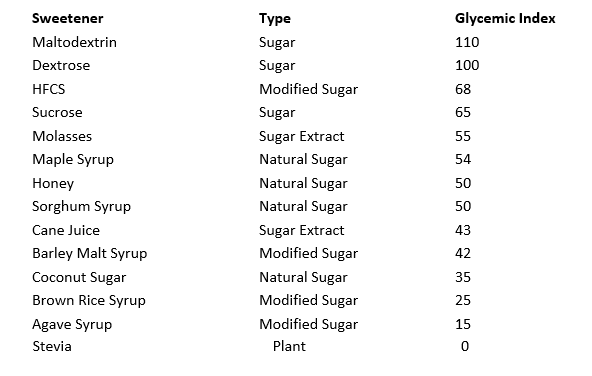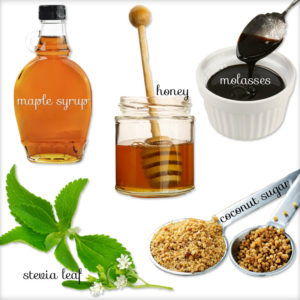Sugar Substitute & “Natural” Sugar Sabotaging Your Health?
The ever-changing messages we are fed from the news and friends … and of course social media and news reports is exhausting and overwhelming. It often leaves our heads spinning!
Americans eat an average of 150 pounds of sugar every year. That breaks down to 0.5 pounds daily! Sadly the ramification of this is a country with skyrocketing Diabetes. According to the Diabetes.org in 2012:
- 29.1 million Americans, or 9.3% of the population, had diabetes.
- Of the 29.1 million, 21.0 million were diagnosed, and 8.1 million were undiagnosed.
- The percentage of Americans age 65 and older remains high, at 25.9%, or 11.8 million seniors (diagnosed and undiagnosed).
- 1.4 million Americans are diagnosed with diabetes every year.
- 86 million Americans age 20 and older had prediabetes; up from 79
 million in 2010.
million in 2010.
And newest research is calling dementia “Type III Diabetes”. 47.5million people suffer with dementia worldwide and this statistic is expected to increase to 75.6 million people by 2030 (and triple by 2050) according to the WHO.
All that said – many of us are trying (hard!) to move toward sugar substitutes. But are they helping or hurting us?
The Yellow Packet: Splenda (sucralose)
Originally was going to be a pesticide and marketed as “made from sugar” has 3 atoms of chlorine (yes – the chemical you add to your pool and town water to reduce bacteria). Research has shown sucralose to destroy the healthy microbiome in our digestive tract. Our microbiome is the key to the immune and metabolic systems.
The Pink and Blue Packets: Aspartame
Equal, sweet & low, amino sweet – Zero calories sweetener 200 times sweeter than sugar but linked to many side effects. There’s even a movie about it’s creation and deception to the public on its risks called AminoSweet… we highly recommend you rent this movie 4 Better Health.
Xylitol:
Sugar alcohol is also known as Xylitol, which is a low-digestible carbohydrate that resists starches and includes fiber. Xylitol can raise blood glucose levels, which suggests that diabetics shouldn’t consume it. On a very important side note, for all of my friends out there with pets, xylitol side effects are very toxic to pets. Many people will have digestive issues (bloating, gas and diarrhea) when consuming xylitol. (*Special precaution for pet owners According to VCA Animal Hospitals xylitol is highly toxic to animals.*)
Agave
Although agave is about 1 1/2 times sweeter than regular sugar and contains roughly 60 calories per tablespoon, which is about 20 calories more than the same amount of table sugar and lower glycemic, it’s a HIGHLY processed sweetener which as a result, strips any “natural” benefit away. At the end of the processing, it contains more fructose than High Fructose Corn Syrup (HFCS). Compared to the 1:1 fructose/glucose ratio of sugar and high fructose corn syrup, agave nearly has a whopping 2:1 ratio for instance.
Maple Syrup
One of the biggest issues with maple syrup is that most of what is sold in store s is actually HFCS. Reading the ingredients is key to consuming REAL maple syrup and not highly processed HFCS. (a little tip when purchasing MS grade B is least processed). The other issue is that it’s not low glycemic. Sure – it’s “Natural” but if your goal is to reduce sugar in the diet – this is not something to lean on.
s is actually HFCS. Reading the ingredients is key to consuming REAL maple syrup and not highly processed HFCS. (a little tip when purchasing MS grade B is least processed). The other issue is that it’s not low glycemic. Sure – it’s “Natural” but if your goal is to reduce sugar in the diet – this is not something to lean on.
Honey:
Many people who use honey are buying the adorable plastic bear on the grocery stores (or target, Walmart, etc). Sadly 77% of the time there is ZERO honey or pollen and most of them are honey flavored sticky brown HFCS. In fact, studies reveal consuming store-bought honey spiked blood glucose by 53% and raw honey only raised it 14%. Although raw REAL honey is superior to maple syrup (especially if it’s local) has many health benefits. That said, like maple syrup it can still be highly glycemic. If you’re eating a jar faster than a month you’re eating too much.
Coconut sugar:
Coconut sugar is a low glycemic and mineral-rich sugar extracted from the blooms of the coconut and then heated. This is a great low glycemic option if you have no issues with coconut.
Stevia
This is made from a plant called Rebaudioside A (a.k.a. Rebiana or Reb A). This is the best option for zero glycemic to completely remove sugar.
Stevia extract is typically about 200 times sweeter than sugar. When it comes to using stevia, you only need a tiny bit at a time to sweeten your morning tea or the next batch of healthy baked goods. When it comes to the stevia options available today, it’s vital to know that not all stevia is created equal. You should be aware of the three main categories of stevia including green leaf stevia, stevia extracts, and altered stevia which often include other ingredients (such as maltodextrin, dextrose and erythritol). “Truvia” is a great example of this going through a 42 step process to make the highly processed sweetener (leaving it only 1% stevia). This point cannot be stressed enough: not all stevia products are created equal.
How do I use Stevia?
You can use stevia powder or liquid stevia extract in place of sugar in your coffee or tea. You can also use it in baking recipes or any other recipe that recommends including sugar. It’s important to realize that a little bit of stevia goes SUCH a long way. You need so much less stevia in comparison to sugar. Conversions will vary depending on your specific stevia product.
Conversions
- 1 teaspoon sugar = 1/2 packet or 1/8 teaspoon powdered stevia = 5 drops liquid
- 1 tablespoon sugar = 1.5 packets or 1/3 teaspoon powdered stevia = 15 drops liquid stevia
- A cup of sugar = 24 packets or 2 tablespoons powdered stevia = 2 teaspoons liquid stevia
Unfortunately, if you are looking for caramelization in a dessert, stevia does not brown like regular sugar.

 “Finding 4 Better Health was a blessing after many years of traditional medicinal doctors /Endocrinologists being unable to get me to feeling optimal. Dr Zub listened to me, truly heard me & devised a proactive plan for me to have a better life. My body is still healing, but I am no longer barely functioning to get through my daily life. I can exercise again without being completely depleted of energy. I have been able to successfully lose 20 pounds. I feel I can always contact Dr. Zub with any questions or concerns I may have. We continue to work together to find the right course of action for my health. I can’t say enough great things about their practice.”
“Finding 4 Better Health was a blessing after many years of traditional medicinal doctors /Endocrinologists being unable to get me to feeling optimal. Dr Zub listened to me, truly heard me & devised a proactive plan for me to have a better life. My body is still healing, but I am no longer barely functioning to get through my daily life. I can exercise again without being completely depleted of energy. I have been able to successfully lose 20 pounds. I feel I can always contact Dr. Zub with any questions or concerns I may have. We continue to work together to find the right course of action for my health. I can’t say enough great things about their practice.”

